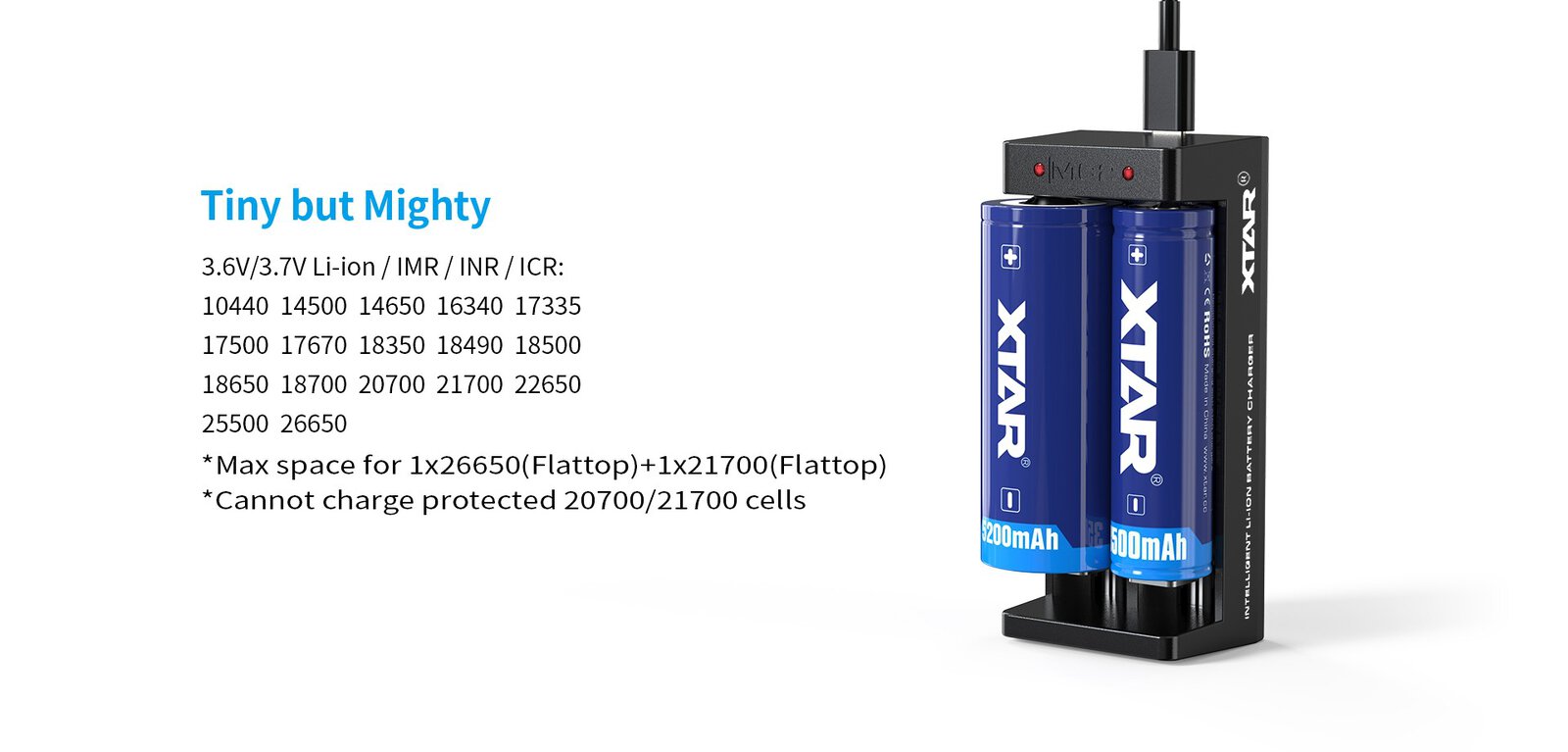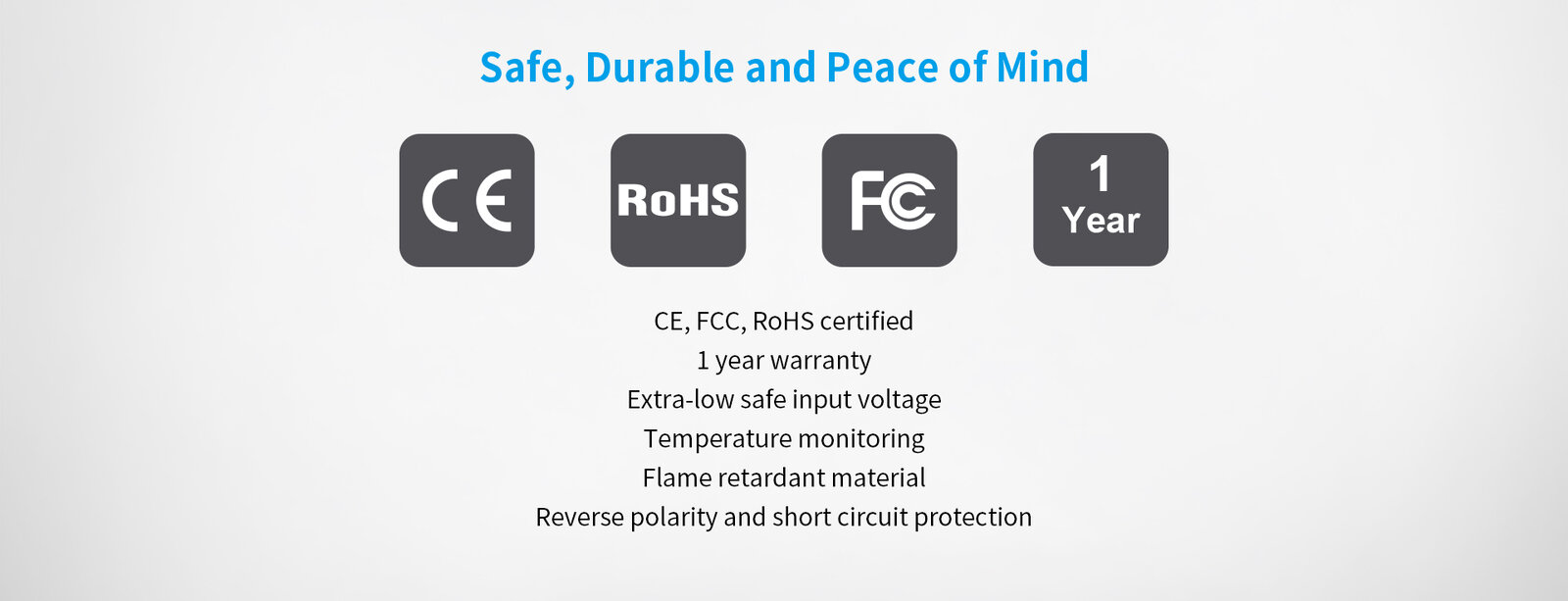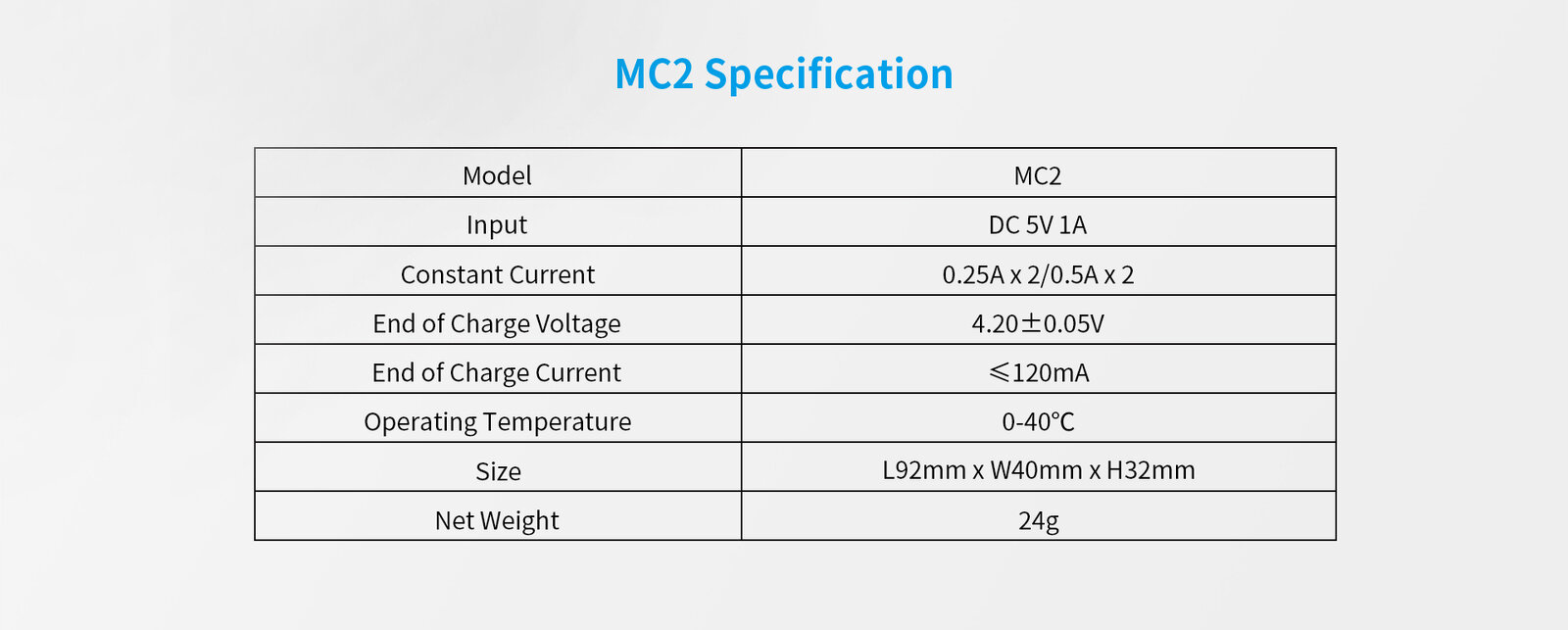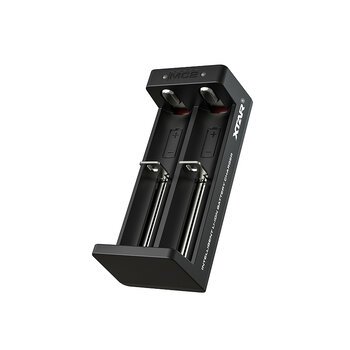
Professional, compact processor chargerXtar MC2 USB-C
for Li-ion batteries in sizes 18650 and others
Key Features
- processor-controlled three-stage TC/CC/CV charging process
- Two Independent Charging Channels
- powered by any USB-C charger or from a computer's USB port (min. 0.5A)
- small size - easy to carry
- function of reactivation of deeply discharged cells
- protections: short-circuit, thermal, reverse polarity protection
!! NEW VERSION WITH CHANGED SOCKET TO USB-C!!

A fully professional processor charger with a three-stage TC/CC/CV charging process is hidden in a small housing. It charges 1-2 Li-ion 3.6/3.7V cells of any capacity in sizes 10440, 14500, 14650, 16340, 17500, 17670, 18350, 18500, 18650, 18700. It is also possible to charge one battery with size 20700, 21700 - only unprotected, 25500, 26500.

What is the TC/CC/CV charging method? It is a three-stage charging process for Li-ion cells, ensuring that the cell is kept in good condition by charging with the appropriate current at each stage and completing the charging process at the right time.
The different stages of the TC/CC/CV process are:
- TC phase: cells discharged below 2.85V are 'woken up' by a lower current.
- CC phase: when 2.85V is reached, the cell is charged with a constant current of 0.5A or 0.25A (depending on the power source used).
- CV phase: when the cell is almost charged, the charger switches to charging with decreasing current until the voltage of 4.2V across the cell is reached. When 4.2V is reached, the charging process is complete - the battery is fully charged.
Batteries with a voltage of 4.1V or higher are treated as charged by the charger. To fully charge such a battery, it must be inserted into the charger before turning it on to the power supply. Charged batteries left in the charger will undergo a natural self-discharge process. Charging will resume when the battery voltage drops below 4.1V.

The Xtar MC2 charger has the function of reactivating deeply discharged cells and cells with a voltage of 0V. Many chargers on the market are not able to charge such batteries. This is where the Xtar MC2 charger comes in handy, which in many cases allows you to 'rescue' such cells. Simply insert a deeply discharged battery into the MC2 charger as you would with normal charging - the charger will detect the discharged cell and attempt to reactivate it.
Remark! Cells discharged below a certain level are irreparably damaged and may not be able to be reactivated. Avoid discharging Li-ion batteries too deeply – this can lead to a significant reduction in their durability and capacity, or lead to their complete inefficiency.
Chargers from other manufacturers can significantly increase the temperature of the charged cells during charging. If the cells get too hot, they can wear out faster. With the MC2 charger, Xtar has gone one step further than the competition by solving this problem in a simple way: it uses power from an external power supply. Thanks to this, the temperature of the battery charged in the MC2 will increase by a maximum of 15 degrees


The Xtar MC2 charger comes with a micro USB cable and a cover to protect the charger during transport. A power adapter is not included. Any charger with a micro USB cable, e.g. from a phone, or a USB socket, or a computer with a free USB port will suffice to power the charger. The recommended charger power is 1A (1000mA).


Produkt posiada oznaczenie CE.
- Akumulatory Li-ion 3,6-3,7V, zabezpieczone (z PCM/PCB)
- Akumulatory Li-ion 3,6-3,7V, niezabezpieczone
- 5 V (500 - 1000 mA)
- Sterowana procesorowo TC/CC/CV dla Li-ion
- 250 lub 500mA ±50mA (zależnie od wykorzystywanego źródła zasilania)
- 4,2V ±0,05V
- Reaktywacja głęboko rozładowanych ogniw i ogniw 0V
- Przed przegrzaniem ładowarki
- Przed przeciążeniem / zwarciem
- Przed odwrotną polaryzacją ogniw
- Ładowanie (Charge)
- Ładowarka MC2, kabel USB-C
- Akumulatory Li-ion 3,6-3,7V, zabezpieczone (z PCM/PCB)
- Akumulatory Li-ion 3,6-3,7V, niezabezpieczone
- 5 V (500 - 1000 mA)
- Sterowana procesorowo TC/CC/CV dla Li-ion
- 250 lub 500mA ±50mA (zależnie od wykorzystywanego źródła zasilania)
- 4,2V ±0,05V
- Reaktywacja głęboko rozładowanych ogniw i ogniw 0V
- Przed przegrzaniem ładowarki
- Przed przeciążeniem / zwarciem
- Przed odwrotną polaryzacją ogniw
- Ładowanie (Charge)
- Ładowarka MC2, kabel USB-C








